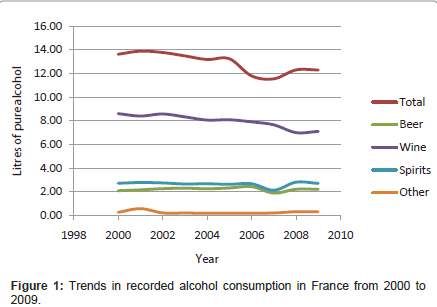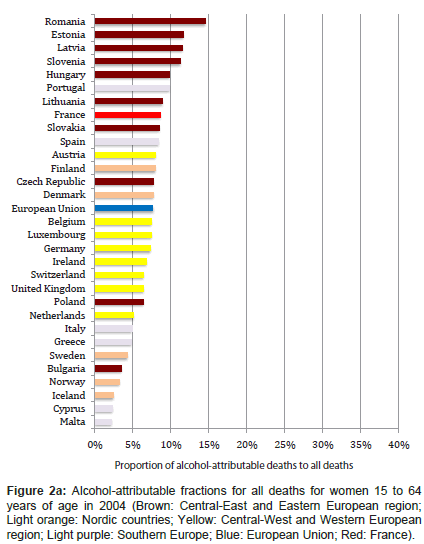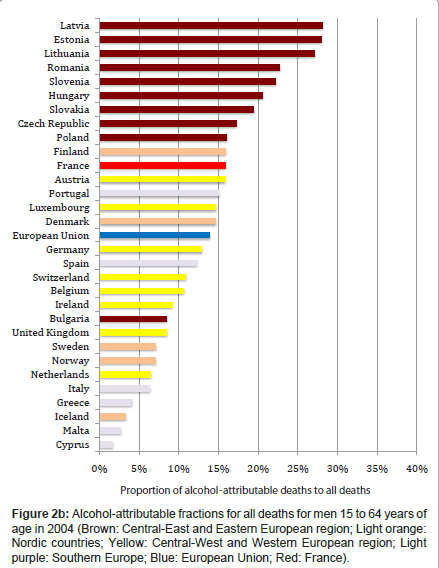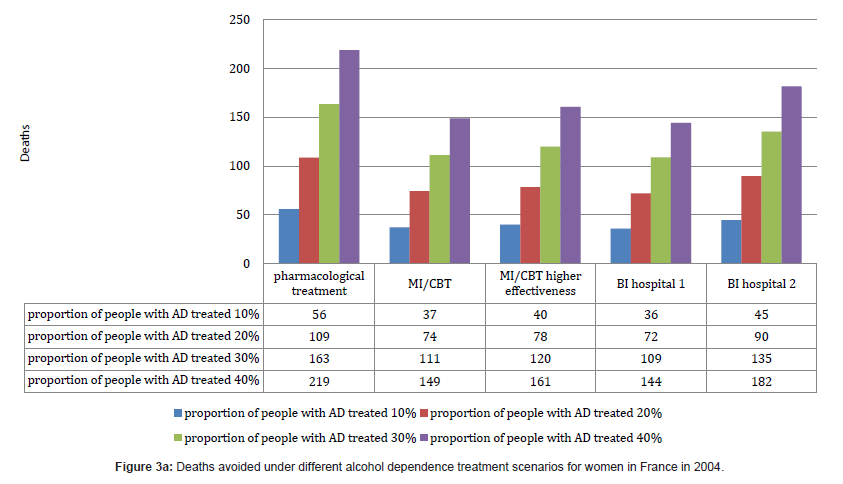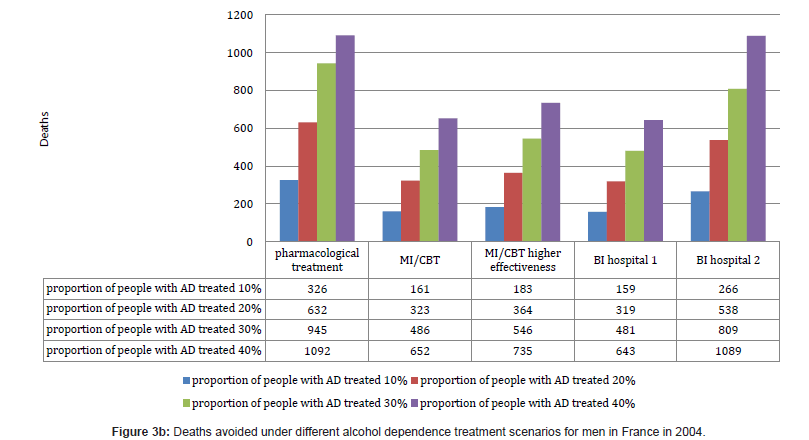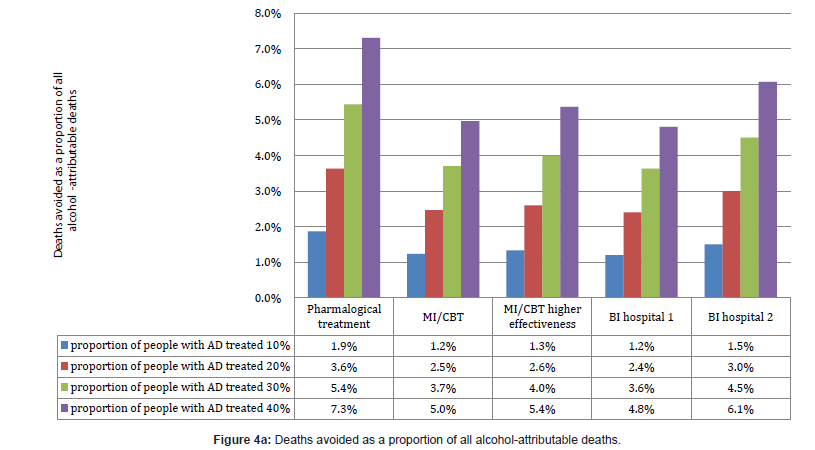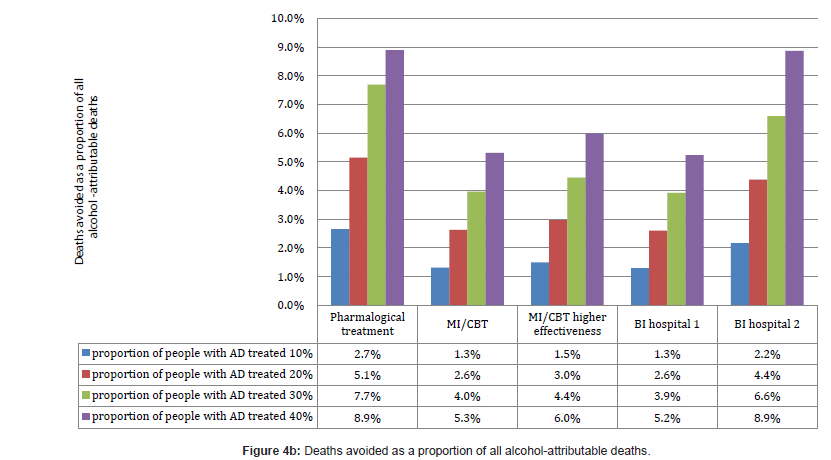Research Article Open Access
Alcohol Consumption, Alcohol Dependence and Related Harms in France:Increasing Public Health by Increasing the Availability of Treatment for Alcohol Dependence
Kevin D Shield1,2*, Jürgen Rehm1-5, Maximilien X Rehm6, Gerrit Gmel1,7 and Henri-Jean Aubin81Centre for Addiction and Mental Health, Toronto, Canada
2Institute of Medical Science, University of Toronto, Canada
3Institute for Clinical Psychology and Psychotherapy, TU Dresden, Germany
4Dalla Lana School of Public Health, University of Toronto, Canada
5Department of Psychiatry, University of Toronto, Canada
6Faculty of Arts and Sciences/Politics and Governance, Ryerson University, Toronto, Canada
7Ecole Polytechnique Fédérale de Lausanne, Lausanne, Switzerland
8Hôspital Paul Brousse, Université Paris-Sud 11, INSERM U669, 94804 Villejuif, France
- *Corresponding Author:
- Kevin D Shield
Centre for Addiction and Mental Health
Toronto, Canada
Tel: +1 647 971 6175
Fax: +1 416 260 4146
E-mail: Kevin.Shield@mail.utoronto.ca
Received February 22, 2013; Accepted April 08, 2013; Published April 23, 2013
Citation: Shield KD, Reh J, Rehm MX, Gmel G, Aubin HJ (2013) Alcohol Consumption, Alcohol Dependence and Related Harms in France: Increasing Public Health by Increasing the Availability of Treatment for Alcohol Dependence. J Addict Res Ther S7:005. doi:10.4172/2155-6105.S7-005
Copyright: © 2013 Shield KD, et al. This is an open-access article distributed under the terms of the Creative Commons Attribution License, which permits unrestricted use, distribution, and reproduction in any medium, provided the original author and source are credited.
Visit for more related articles at Journal of Addiction Research & Therapy
Abstract
Objectives: To estimate the number of deaths due to alcohol consumption and alcohol dependence, and the number of deaths avoided if alcohol dependence treatment coverage rates had been increased in France in 2004.
Methods: Alcohol-attributable deaths and the effects of increasing the coverage rate for alcohol dependence treatment were estimated for France in 2004 using alcohol-attributable fractions and simulations. Data on alcohol dependence, alcohol consumption and mortality were obtained from the Gender, alcohol and culture: an international study, the Global Information System on Alcohol and Health, and the 2004 Global Burden of Disease study respectively.
Results: In France in 2004 15,282 deaths (2,998 female deaths; 12,284 male deaths) or 13.6% of all deaths (8.7% of all female deaths; 15.8% of all male deaths) of people 15 to 64 years of age were estimated to be attributable to alcohol consumption. Of these deaths, 70.3% (60.5% for females; 72.7% formales) were attributable to heavy drinking, and 61.6% (42.4% for females; 66.3% for males) were attributable to alcohol dependence. Increasing coverage of pharmacological alcohol dependence treatment (the most effective treatment for people with alcohol dependence in France) to 40% would result in an estimated reduction of 7.3% (219 deaths/year) of all female and 8.9% (1092 deaths/ year) of all male alcohol-attributable deaths.
Conclusion: The burden of alcohol-attributable deaths in France is large and preventable. An increase in France of treatment coverage for alcohol dependence could reduce a large proportion of the alcohol-attributable burden of disease.
Keywords
Alcohol; Mortality; Alcohol dependence; Alcohol dependence treatment; France; Europe; Mortality
Introduction
The tradition of consuming alcohol has long been a part of European culture, especially in France. Each region of France has a unique pattern of drinking which is associated with geographical location. Many regions of France, especially in the south, follow a traditional Mediterranean drinking style, with daily drinking, often with meals, and wine as the traditional beverage of choice [1]. The northern regions exhibit drinking patterns which more closely resemble those of other neighboring high-income European Union (EU) countries, such as the United Kingdom, the Netherlands and Germany [1]. These patterns of drinking feature proportionally a higher consumption of beer and spirits; however, for all regions of France wine is the most consumed alcoholic beverage [2,3]. Binge drinking behaviours are generally in frequent, but recent increases have been observed, especially among adolescents [4,5].
Alcohol is an essential cause in over 200, three-digit International Classification of Diseases (10th revision) codes [6,7] for an overview of the diseases that are causally linked with alcohol consumption. Alcohol consumption was the third leading risk factor for premature death and disability globally in 2004, responsible for 3.8% of all mortality or 2,300,000 deaths [8].
One of the most severe health consequences of alcohol consumption is Alcohol Dependence (AD), which is a maladaptive pattern of consumption, characterized by a loss of control, leading to clinically significant impairment or distress. AD also results in a higher chance of alcohol-attributable diseases (such as liver cirrhosis) and severe social problems (e.g., loss of productivity, divorce), as well as potential societal costs. As is the case in all European countries, AD is largely undertreated in France. From 2001 to 2003, it was estimated that in France, less than 10% of all people with AD receive treatment [9]. Thus, improving coverage rates of AD treatment may potentially be an effective way of reducing the alcohol-attributable burden of disease.
There is an absence of up-to-date estimates of the number of deaths attributable to alcohol consumption, heavy drinking and AD, and an absence of estimates of the effects of increasing AD treatment coverage in France on the alcohol-attributable burden of disease. Accordingly, the objective of this article is to calculate for France for 2004 the alcohol-attributable burden of disease caused by alcohol consumption, heavy alcohol consumption and AD, and to estimate the effect of increasing the coverage of AD treatments on the alcohol-attributable burden of disease.
Methods
Alcohol consumption and dependence data
Data for the prevalence of current drinkers (people who have consumed at least one standard drink of alcohol in the past year), former drinkers (people who have consumed at least one standard drink of alcohol, but did not do so in the past year), and lifetime abstainers (people who have never consumed at least one standard drink) differentiated by sex and age were obtained from the Gender, alcohol and culture: an international study (GENACIS) survey [10,11]. Data for per capita consumption of alcohol were obtained from a government survey of the World Health Organization and the Global Information System on Alcohol and Health [12,13].
The 2005 pattern of drinking score for France (a composite measure assessing at the population level the manner in which individuals consume alcohol [14,15] was obtained from the 2005 Global Burden of Disease (GBD) study.
To correct for the under coverage of alcohol consumption measured in surveys [16], we triangulated the survey data with data on per capita consumption using methods published by Rehm et al. [17,18] for full details of the mathematical models). This triangulation method assumes that the alcohol consumption distribution will follow a Gamma distribution [17]. The first step in this method is the calculation of sex-specific mean alcohol consumption using population level alcohol consumption data(obtained from per capita consumption estimates), data on the prevalence of current drinkers (obtained from population surveys), and the relative amounts of alcohol consumed differentiated by sex (obtained from population surveys). The second step is the calculation of the scale parameter of the alcohol consumption Gamma distribution for both sexes. The scale parameter is calculated using the association between the mean alcohol consumption and the variance of a population level alcohol consumption Gamma distribution as described by Kehoe et al. [17].
Data on AD for France was obtained from the World Mental Health Survey [19,20]. These data likely underestimate the true population prevalence of AD, as questions used to measure AD in the World Mental Health Survey were only asked of those respondents who scored positively on questions relating to alcohol abuse [21]. To correct for this under coverage of AD, data from the World Mental Health Survey were combined with data from the German Mental Health Survey, where both dependence and abuse were assessed independently [22,23].
Modelling alcohol-attributable mortality and morbidity
To calculate the alcohol-attributable burden of disease, we utilized Alcohol-Attributable Fractions (AAFs), where an AAF is defined as the percentage of morality that would not occur if everyone was a lifetime abstainer. For diseases and conditions that are entirely attributable to alcohol consumption (i.e. where alcohol is a necessary cause in the development of the disease or condition, such as AD), the AAF is equal to 1. For alcohol-related diseases, conditions and injuries where alcohol is not a necessary cause, we calculated the AAFs by combining exposure indicators and Relative Risk (RR) functions Rehm et al. [1] for a discussion of the AAF calculation methodology for total alcohol consumption, heavy alcohol consumption and AD, and for the RR functions for each disease modeled.
Modelling the effects of treatment for Alcohol Dependence
To estimate the effects on alcohol-attributable mortality of increasing AD treatment rates, we simulated the effects of an increase in coverage of AD treatment, assuming 10%, 20%, 30% and 40% of all people with AD were receiving treatment. For these simulations, we examined the effects of increasing the AD treatment coverage for five different treatments: pharmacological treatment [24,25], Motivational Interviewing/Cognitive Behavioral Therapy (MI/CBT) [26,27], MI/CBT assuming the upper level of effectiveness, and Brief Interventions (BI) (in two different hospital settings) [28]. Web Appendix 1 outlines the assumptions used when modeling the effects of AD treatments on alcohol consumption and mortality [1,29].
For our simulation model, we generated 100,000 data points or “drinkers” to represent the drinking population of France. The data points that were identified as drinkers with AD were selected randomly among the heavy drinkers (men who consume 72 grams or more of pure alcohol per day and women who consume 48 grams or more of pure alcohol per day), with the total number of data points selected being equal to the number of people in France with AD among every 100,000 drinkers. As the effect of treatment interventions can be translated into a shift in average alcohol consumption or as a decrease in the RR of mortality, the effects of interventions were calculated using AAFs. The AAFs were evaluated before and after interventions and the differences between the estimates were used to calculate the deaths prevented for each given increase in treatment coverage. Sensitivity analyses were performed using AD prevalence estimates data from Lepine et al. [30] (these estimates are from the European Study of the Epidemiology of Mental Disorders survey (part of the World Mental Health Survey), but are unadjusted for under coverage of AD as described above).
Mortality and morbidity data
Data on the number of deaths by cause for 2004 were obtained from the 2004 GBD Study [31]. The data from the 2004 GBD study was the latest year for mortality data (estimated using a consistent methodology) to which the authors had access.
Population data
Data on population estimates for France and other European countries for 2005 were obtained from the 2005 GBD study [32].
Software
All analyses were performed using R version 2.13.0 [33] and Mathematica version 8 [34].
Results
Alcohol consumption in France
In France in 2009 adult per capita consumption of alcohol was 12.7 liters (0.4 liters of which is estimated to be unrecorded), very close to the EU average of 12.5 liters, with wine being the most consumed beverage by far: 62% of all alcohol consumed was wine, beer accounted for 17% of all alcohol consumed, and spirits accounted for 20% of all alcohol consumed. Figure 1 depicts recorded per capita consumption of alcohol by beverage type from 2000 to 2009. Alcohol consumption in France has consistently decreased from the early 1960s (adult per capita consumption was 26.0 liters in 1961). Wine has been the dominant drink of choice, accounting for 20.6 recorded per capita liters in 1961, which was close to 80% of all recorded alcohol consumed. Aside from negligible increases in recorded per capita consumption of some alcoholic beverages from 2007 to 2008, the downward trend in consumption has continued, driven mainly by a decrease in recorded per capita consumption of wine.
France’s pattern of drinking score is currently 1 (the least detrimental level), indicating generally healthy drinking habits, such as relatively little drinking to intoxication and drinking with meals. In 2004, 7% of drinkers consume more than 5 drinks on any occasion several times a week, 13% do so once a week, and 15% do so once a month. These percentages are below the EU average.
Alcohol dependence in France
It is estimated that 3.4% of people in France 15 years of age and older (1.5% of women and 5.3% of men) were alcohol dependent. This corresponds to 1,286,400 people (284,700 women and 1,001,700 men) in 2005 [1].
Alcohol-attributable harms
In France in 2004, 15,300 deaths (3,000 female deaths; 12,300 male deaths) or 13.6% of all deaths (8.7% of all female deaths; 15.8% of all male deaths) of people 15 to 64 years of age were attributable to alcohol consumption. This corresponds to approximately 1 in 12 women and 1 in 6 men dying prematurely due to alcohol. The rate of alcohol-attributable mortality for France in 2004 was 15.1 per 100,000 women and 61.8 per 100,000 men, in each case for people aged 15 to 64 years. This mortality rate places France 13th among the 30 investigated European countries (the EU countries, Iceland, Norway and Switzerland). This ranking system is constructed such that the top ranked country experiences the most alcohol-attributable harms adjusted for population size and population structure. Figure 2a presents the proportion of alcohol-attributable deaths to all deaths for women 15 to 64 years of age for the European countries examined, and Figure 2b presents this same information for men 15 to 64 years of age.
Heavy consumption of alcohol in France in 2004 was responsible for 10,700 deaths (1,800 female deaths and 8,900 male deaths or 9.6% of all deaths (5.2% of female deaths and 11.5% of men deaths) of people 15 to 64 years of age. This corresponds to 70.3% of all alcohol-attributable deaths (60.5% of all alcohol-attributable deaths of women and 72.8% of all alcohol-attributable deaths of men).
In France in 2004 AD was responsible for 9,300 deaths (1,200 female deaths and 8,100 male deaths) or 8.4% of all deaths (3.7% of all deaths of women and 10.5% of all deaths of men) of people 15 to 64 years of age. This corresponds to 61.6% of all alcohol-attributable deaths (42.4% of all alcohol-attributable deaths of women and 66.3% of all alcohol-attributable deaths of men).
Effects of potential treatment interventions
If the proportion of people with AD who were given pharmacological AD treatment rose to 20%, there would be a resulting reduction of 3.6% (109 deaths/year) of all female and 5.1% (632 deaths/year) of all male alcohol-attributable deaths of people 15 to 64 years of age. Increasing the prevalence of pharmacological AD treatment coverage to 40% would result in a reduction of 7.3% (219 deaths/year) of all female and 8.9% (1092 deaths/year) of all male alcohol-attributable deaths. The second most effective intervention is BI Hospital (2), with a prevalence of 20% of people with AD treated resulting in a reduction of 3.0% (90 deaths/year) of female and 4.4% (538 deaths/year) of male alcohol-attributable deaths of people 15 to 64 years of age. These interventions were followed (in order of effectiveness) by MI/CBT and BI Hospital 1. The effects of increasing pharmacological AD treatment to 40% in France, when compared to the other European countries examined, would be comparatively higher for women (where France ranked 13th for the population adjusted rate of alcohol-attributable deaths prevented) when compared to men (where France ranked 22nd in the EU). The most effective intervention, as with all other countries that were examined, was pharmacological treatment. Figures 3a and 3b outline the number of alcohol-attributable deaths prevented in France under different treatment coverage rates, and figures 4a and 4b outline the percentages of all alcohol-attributable deaths that would be prevented under different treatment coverage rates. The full results of the main analysis are outlined in appendix 2.
We observed from the sensitivity analyses using AD prevalence estimates from Lepine et al. [30] that pharmacological treatment remains the most effective, with 2.9% of all alcohol-attributable deaths (for both men and women) being prevented if 20% of all people with AD are treated. This estimate rises to 5.6% of all female and 6.0% of all male alcohol-attributable deaths being prevented if 40% of all people with AD undergo pharmacological treatment. Similar to the main analysis, BI Hospital 2 is the second most effective treatment resulting in a reduction of 4.9% of all female and 5.3% of all male alcohol-attributable deaths of people 15 to 64 years of age if treatment coverage rises to 40%.
Discussion
In France in 2004 alcohol consumption was responsible for approximately 15,300 deaths (3,000 deaths of women (1 in 12 deaths) and 12,300 deaths of men (1 in 6 deaths)) for people15 to 64 years of age. If recent trends of increased binge drinking continue (especially in adolescents and young adults) [4,5], France’s pattern of drinking score may increase to a more detrimental value. This increase in binge drinking will also lead to an increase in the number of alcohol-attributable deaths from alcohol-related diseases, such as ischemic heart disease [35,36] and from intentional and unintentional injuries [16]. Given the magnitude of the alcohol-attributable burden of disease in France, it is imperative to assess the effectiveness of policies and interventions that can reduce this burden.AD is responsible for a large proportion of the alcohol-attributable burden of disease in France, and the current AD treatment coverage rate for France is low, with less than 10% of people with AD being treated. Accordingly, one area for improvement would be to increase treatment coverage rates for people in France with AD [1,29]. In particular, if coverage of pharmacological AD treatment (the most effective treatment observed) were to increase to 40% of all people with AD, we estimated the resulting prevention of 1,311 alcohol-attributable deaths per year in France. Introducing brief interventions in hospitals would also result in similar benefits; people in hospitals have a higher risk of mortality, and reducing alcohol consumption has overly proportional effects in reducing mortality for this group [28]; according to the latest Cochrane analyses, after brief interventions in hospitals the mortality rate within 1 year of the intervention was reduced by 40%.
Our analysis has certain limitations. Information concerning cause of death has long been seen as containing inaccuracies [37], and more recent studies confirm considerable degrees of error in such information [38,39]. Due to the unreliable nature of mortality data, especially for people older than 64 years of age, we excluded individuals who were 65 years or older when performing our analysis.
Exposure estimates for drinking status and binge drinking patterns used in our analysis were measured in 2009, whereas outcomes were measured in 2004; however, the short length of time between 2004 and 2009 should not greatly affect the alcohol-attributable mortality estimates for France, as alcohol consumption in France has remained relatively stable during this time period [12]. The estimates of alcohol consumption used in our analysis were also cross-sectional, i.e., measured more or less concurrently with deaths, whereas long-term patterns of alcohol consumption impact the risk of some chronic diseases such as cancer [40]. Furthermore, our analysis did not include aspects of harms to others (such as motor vehicle accidents, and assaults), which recently have been shown to constitute a large proportion of the burden of injury attributable to alcohol [41].
It is important to note that AD treatment is commonly a combination of therapies, and the results of this study are limited to the effects of single interventions; there may be combinations of interventions that produce more effective results [42]. Thus, the potential decrease in alcohol-attributable mortality in France by increasing AD therapy may be greater than described in this article for the most effective combinations of AD therapies. Additionally, although there is error associated with the estimates of the effectiveness of AD therapy, with the mortality data, and with the alcohol consumption data, the error was not calculated for the potential decrease in alcohol-attributable mortality due to different treatment interventions as the error associated with the estimates of mortality by cause was not available.
Psychotherapy, sometimes combined with pharmacotherapy, is the most common type of AD therapy used in France. The most commonly used psychoanalytic procedures (from most frequent to less frequent) are MI, self-help group facilitation, BIs, CBT, and psychodynamic interventions (based on unpublished study findings).Based on our findings, increasing the proportion of people with AD who undergo pharmacotherapy could help to reduce the alcohol-attributable burden of disease in France.
Alcohol consumption is a major risk factor for mortality in France. More substantial alcohol policies and improved coverage of AD treatments are possible avenues to reduce alcohol consumption and the resulting burden of disease. Effective improvement of the coverage rates of AD treatments in France would result in the prevention of a large number of alcohol-attributable deaths since AD treatment coverage rates in that country are currently very low. Thus, increasing AD treatment coverage rates in addition to implementing measures aimed at reducing alcohol consumption should be considered by policy makers in France to reduce that country’s large alcohol-attributable burden of disease [43].
Acknowledgements
Lundbeck provided financial support for this study via an unrestricted grant. Lundbeck had no influence on the data gathering or design of this study. Jürgen Rehm received in the past few years unrestricted grants from Eli Lilly, Schering-Plough and Lundbeck, and is a member of the scientific advisory council for Nalmefene.
References
- Rehm J, Shield K, Rehm M, Gmel G, Frick U (2012) Alcohol consumption, alcohol dependence, and attributable burden of diseasen in Europe: potential gains from effective interventions for alcohol dependence. Toronto, Canada.
- Com-Ruelle L, Dourgnon P, Jusot F, Lengagne P (2008) Alcohol consumption in France: one more glass of French paradox. Issues in Health Economics 129: 1-6.
- Kesse E, Boutron-Ruault MC, Clavel-Chapelon F; E3N group (2005) Regional dietary habits of French women born between 1925 and 1950. Eur J Nutr 44: 285-292.
- Beck F, Guignard R, Richard JB, Tovar ML, Spilka S (2011) Les niveaux d'usage de drogues en France en 2010. Tendances 76: 1-6.
- Spilka S, Le Nézet O, Tovar ML (2012) Les drogues à 17 ans : premiers résultats de l'enquête ESCAPAD 2011. Tendances, 79: 1-4.
- World Health Organization (2007) International classification of diseases and related health problems, 10th revision. Geneva, Switzerland: World Health Organization.
- Rehm J, Baliunas D, Borges GL, Graham K, Irving H, et al. (2010) The relation between different dimensions of alcohol consumption and burden of disease: an overview. Addiction 105: 817-843.
- World Health Organization (2009) Global Health Risks. Mortality and burden of disease attributable to selected major risks. Geneva, Switzerland: World Health Organization.
- Alonso J, Angermeyer MC, Bernert S, Bruffaerts R, Brugha TS, et al. (2004) Use of mental health services in Europe: results from the European Study of the Epidemiology of Mental Disorders (ESMeD) project. Acta Psychiatr Scand Suppl 109: 47-54.
- Bloomfield K, Allamani A, Beck F, Bergmark KH, Csemy L, et al. (2005) Gender, culture and alcohol problems: a multi-national study. An EU concerted Action. Project final report, Berlin, Germany.
- Bloomfield K, Gmel G, Wilsnack S (2006) Introduction to special issue 'Gender, Culture and Alcohol Problems: a Multi-national Study'. Alcohol Alcohol Suppl 41: i3-7.
- World Health Organization (2011) Global status report on alcohol and health. Geneva, Switzerland: World Health Organization.
- World Health Organization (2012) Global Information System on Alcohol and Health. Geneva, Switzerland
- Rehm J, Rehn N, Room R, Monteiro M, Gmel G, et al. (2003) The global distribution of average volume of alcohol consumption and patterns of drinking. Eur Addict Res 9: 147-156.
- Rehm J, Room R, Monteiro M, Gmel G, Graham K, et al. (2004) Alcohol Use. In M. Ezzati, A. D. Lopez, A. Rodgers & C. J. L. Murray (Eds.), Comparative quantification of health risks: global and regional burden of disease attributable to selected major risk factors (Vol. 1, pp. 959-1109). Geneva, Switzerland: World Health Organization.
- Shield KD, Gmel G, Patra J, Rehm J (2012) Global burden of injuries attributable to alcohol consumption in 2004: a novel way of calculating the burden of injuries attributable to alcohol consumption. Popul Health Metr 10: 9.
- Kehoe T, Gmel G, Shield KD, Gmel G, Rehm J (2012) Determining the best population-level alcohol consumption model and its impact on estimates of alcohol-attributable harms. Popul Health Metr 10: 6.
- Rehm J, Kehoe T, Gmel G, Stinson F, Grant B, et al. (2010) Statistical modeling of volume of alcohol exposure for epidemiological studies of population health: the US example. Popul Health Metr 8: 3.
- Alonso J, Angermeyer MC, Bernert S, Bruffaerts R, Brugha TS, et al. (2004) Prevalence of mental disorders in Europe: results from the European Study of the Epidemiology of Mental Disorders (ESEMeD) project. Acta Psychiatr Scand Suppl 109: 21-27.
- Kessler RC, Üstün B (2008) The WHO world mental health surveys: Global perspectives of mental health surveys. First Edition, New York.
- Grant BF, Compton WM, Crowley TJ, Hasin DS, Helzer JE, et al. (2007) Errors in assessing DSM-IV substance use disorders. Arch Gen Psychiatry 64: 379-380.
- Jacobi F, Wittchen HU, Holting C, Höfler M, Pfister H, et al. (2004) Prevalence, co-morbidity and correlates of mental disorders in the general population: results from the German Health Interview and Examination Survey (GHS). Psychol Med 34: 597-611.
- Jacobi F, Wittchen HU, Hölting C, Sommer S, Lieb R, et al. (2002) Estimating the prevalence of mental and somatic disorders in the community: aims and methods of the German National Health Interview and Examination Survey. Int J Methods Psychiatr Res 11: 1-18.
- Rösner S, Hackl-Herrwerth A, Leucht S, Lehert P, Vecchi S, et al. (2010) Acamprosate for alcohol dependence. Cochrane Database Syst Rev 9: CD004332.
- Rösner S, Hackl-Herrwerth A, Leucht S, Vecchi S, Srisurapanont M, et al. (2010) Opioid antagonists for alcohol dependence. Cochrane Database Syst Rev 12: CD001867.
- Magill M, Ray LA (2009) Cognitive-behavioral treatment with adult alcohol and illicit drug users: a meta-analysis of randomized controlled trials. J Stud Alcohol Drugs 70: 516-527.
- Smedslund G, Berg RC, Hammerstrøm KT, Steiro A, Leiknes KA, et al. (2011) Motivational interviewing for substance abuse. Cochrane Database Syst Rev 11: CD008063.
- McQueen J, Howe TE, Allan L, Mains D, Hardy V (2011) Brief interventions for heavy alcohol users admitted to general hospital wards. Cochrane Database Syst Rev 8: CD005191.
- Rehm J, Shield KD, Gmel G, Rehm MX, Frick U (2013) Modeling the impact of alcohol dependence on mortality burden and the effect of available treatment interventions in the European Union. Eur Neuropsychopharmacol 23: 89-97.
- Lépine JP, Gasquet I, Kovess V, Arbabzadeh-Bouchez S, Nègre-Pagès L, et al. (2005) [Prevalence and comorbidity of psychiatric disorders in the French general population]. Encephale 31: 182-194.
- Lora A, Kohn R, Levav I, McBain R, Morris J, et al. (2012) Service availability and utilization and treatment gap for schizophrenic disorders: a survey in 50 low- and middle-income countries. Bull World Health Organ 90: 47-54, 54A-54B.
- Institute of Health, Metrics, & Evaluation (2012) Global Burden of Diseases, Injuries and Risk Factors Study Operations Manual. Seattle, USA
- R Development Core Team (2011) R: A Language and Environment for Statistical Computing (version 2.11.0). Vienna, Austria: R Foundation for Statistical Computing.
- Wolfram Research Inc (2011) Mathematica, Version 7.0. Champaign, IL: Wolfram Research Inc.
- Roerecke M, Rehm J (2010) Irregular heavy drinking occasions and risk of ischemic heart disease: a systematic review and meta-analysis. Am J Epidemiol 171: 633-644.
- Roerecke M, Rehm J (2012) The cardioprotective association of average alcohol consumption and ischaemic heart disease: a systematic review and meta-analysis. Addiction 107: 1246-1260.
- JAMES G, PATTON RE, HESLIN AS (1955) Accuracy of cause-of-death statements on death certificates. Public Health Rep 70: 39-51.
- Nashelsky MB, Lawrence CH (2003) Accuracy of cause of death determination without forensic autopsy examination. Am J Forensic Med Pathol 24: 313-319.
- Shojania KG, Burton EC, McDonald KM, Goldman L (2003) Changes in rates of autopsy-detected diagnostic errors over time: a systematic review. JAMA 289: 2849-2856.
- Bagnardi V, Blangiardo M, La Vecchia C, Corrao G (2001) Alcohol consumption and the risk of cancer: a meta-analysis. Alcohol Res Health 25: 263-270.
- Laslett AM, Catalano P, Chikritzhs T, Dale C, Doran C, et al. (2010) The range and magnitude of alcohol's harm to others. Fitzroy, Vic: Turning Point Alcohol & Drug Centre.
- Balldin J, Berglund M, Borg S, Månsson M, Bendtsen P, et al. (2003) A 6-month controlled naltrexone study: combined effect with cognitive behavioral therapy in outpatient treatment of alcohol dependence. Alcohol Clin Exp Res 27: 1142-1149.
- Shield KD, Rehm J (2012) Difficulties with telephone-based surveys on alcohol consumption in high-income countries: the Canadian example. Int J Methods Psychiatr Res 21: 17-28.
Relevant Topics
- Addiction Recovery
- Alcohol Addiction Treatment
- Alcohol Rehabilitation
- Amphetamine Addiction
- Amphetamine-Related Disorders
- Cocaine Addiction
- Cocaine-Related Disorders
- Computer Addiction Research
- Drug Addiction Treatment
- Drug Rehabilitation
- Facts About Alcoholism
- Food Addiction Research
- Heroin Addiction Treatment
- Holistic Addiction Treatment
- Hospital-Addiction Syndrome
- Morphine Addiction
- Munchausen Syndrome
- Neonatal Abstinence Syndrome
- Nutritional Suitability
- Opioid-Related Disorders
- Relapse prevention
- Substance-Related Disorders
Recommended Journals
Article Tools
Article Usage
- Total views: 17483
- [From(publication date):
specialissue-2013 - Apr 21, 2025] - Breakdown by view type
- HTML page views : 12835
- PDF downloads : 4648

